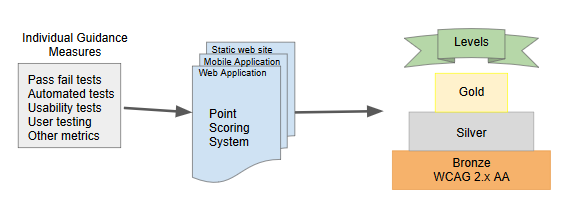This has not been written yet.
How WCAG content has moved to Silver
Explanation - Lorem ipsum dolor sit amet, consectetur adipiscing elit, sed do eiusmod tempor incididunt ut labore et dolore magna aliqua. Ut enim ad minim veniam, quis nostrud exercitation ullamco laboris nisi ut aliquip ex ea commodo consequat.
In summary:
- Principle -> tags. Since many WCAG success criteria could fit under multiple Principles, this gives us greater flexibility to assign Principles.
- Guidelines and technology neutral SC -> Guidelines
- Technology specific SC and Techniques -> Methods
- Understanding becomes part of the long description of Guidelines or Methods. It will be broken up. Use of Color would go toward a Guideline, but the examples are technology specific and would go to a Method.
- Levels (A, AA, AAA) are deleted. Silver levels will be overall for the product/project, not by SC.
- SC numbers are deleted. Guidance will be known by a unique handle, so that Silver scales for new guidance.
